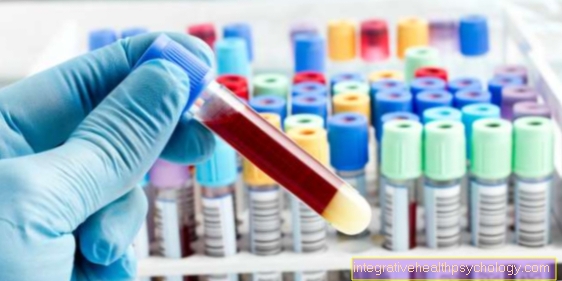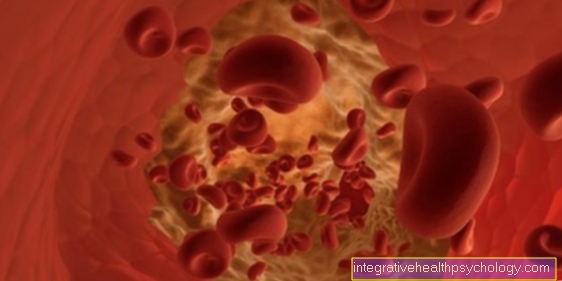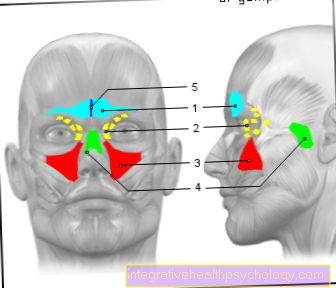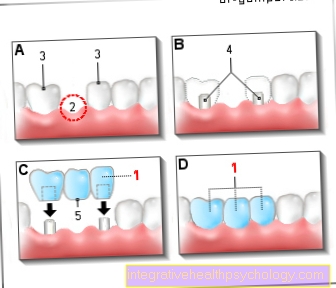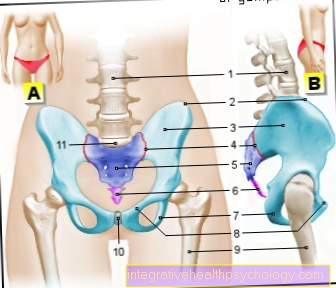Tamoxifen
introduction
The active ingredient tamoxifen, which is usually used in salt form, i.e. as tamoxifen dihydrogen citrate, is a selective estrogen receptor modulator (SERM). In the past, the active ingredients in this group were also known as anti-estrogens. Active substances in this group mediate their effect via estrogen receptors, which are present in various tissues such as the pituitary gland (pituitary gland), the breast, the uterus and the bones. Put simply, tamoxifen causes a reduction in cell division in estrogen-dependent tissues; on the one hand, tissue perishes and, on the other hand, further growth of the tissue is prevented. Tamoxifen is usually supplied as a film-coated tablet. The tablets contain either 10 mg, 20 mg, 30 mg or 40 mg of tamoxifen. The attending physician determines the dosage to be used. A dosage of 20 mg daily is usually sufficient. Tamoxifen is a prescription drug.
Pharmacokinetics
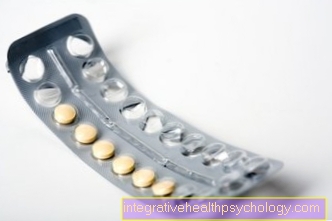
Tamoxifen is a Prodrug, that is, a poorly active pharmacological substance that is only converted into the active ingredient by metabolism in the body. In the case of tamoxifen, this is one Enzyme of the cytochrome P450 enzyme family responsible. The enzyme bears the name CYP2D6 and converts tamoxifen into the active metabolite Endoxifene around. It is known that the gene for the enzyme CYP2D6 can be structured differently in different individuals (Gene polymorphism). This means that the activation step from tamoxifen to endoxifen can take place at different speeds in different people. With so-called Slow metabolisers the activation and thus also the effect of the active ingredient is delayed, which is why these patients can benefit from an alternative therapy. In general, a determination of the CYP2D6 genotypein order to rule out any abnormalities in the gene before starting treatment.
Mode of action (pharmacodynamics)
As already described, Tamoxifen is one of the selective ones Estrogen Receptor Modulators (SERM)that their effect is through bonding to Estrogen receptors unfold. The active metabolites 4-hydroxytamoxifen and endoxifen, for example, which are formed from tamoxifen, have an even stronger bond to estrogen receptors.
Tamoxifen can be called a Partial agonist are designated. A partial agonist is a substance that binds to a receptor and thus the effect of the actual substance that binds to this receptor (for example the hormone Estrogen in the case of the estrogen receptor), partially mimicked. In comparison to a full agonist, a partial agonist only causes incomplete activation of the signal cascade associated with the receptor. Because a partial agonist prevents the binding of the full agonist or displaces it from its binding, the effect of the full agonist is partially inhibited by a partial agonist. With regard to tamoxifen, this means that on the one hand, tamoxifen is a estrogenic active component, but on the other hand also one antiestrogenic active component having. The anti-estrogenic active component comes about through the displacement of estrogen from its receptor binding. Which component predominates depends on the Tissue type from. in the Breast tissue is predominantly the Type ER Estrogen Receptor? found on which tamoxifen has an anti-estrogenic effect. This can reduce the anti-tumor effects of tamoxifen Breast cancer to explain. The estrogenic effects of tamoxifen on the uterus lets the increased occurrence of benign and malignant changes in the uterus and the Uterine lining to explain.
Applications (indications)
Tamoxifen as an antiestrogen is used after the initial treatment Breast cancer (Breast cancer) as supportive Long term therapy used for at least five years. In addition, there is also one in therapy metastatic breast cancer for use. One speaks of a metastatic breast cancer if the breast cancer is already for Daughter tumors, so-called Metastases, has taken care of. A therapy with is effective Tamoxifen only if im Tumor tissue Estrogen receptors could be detected. The presence of estrogen receptors can be determined with the help of a Tissue samplethat are part of a biopsy or one surgery was won by one Pathologists to be established. The clinical application of tamoxifen has shown that tamoxifen is effective in postmenopausal Women to improve Blood lipid levels can lead. A reduction in the Total cholesterol and des LDL of 10-20% are shown. In addition, the Bone density noticed in postmenopausal women. Usually there is a decrease in bone density in women in the menopause. Tamoxifen is also approved for in the United States of America Prevention of breast cancer in high-risk patients.
Contraindication
Tamoxifen must not be used if you are known to be hypersensitive to the active ingredient tamoxifen or any of the other ingredients.
In addition, use in the pregnancy, Lactation and not provided for children and adolescents under 18 years of age.
Adverse drug effects
1. Endocrine system, genital organs
Adverse drug effects from Tamoxifen are largely due to its effect on the Endocrine system to explain. Hot flashes, discharge and menstrual cycle disorders up to the complete absence of the monthly Menstrual period before the actual Menopause are very often complained about taking tamoxifen. Often is over Pruritus (itching) in the genital area and Bleeding reported from the vagina. Benign and malignant changes in the uterus and the uterine lining can also occur more frequently. The appearance of a malignant change in the lining of the uterus (Endometrial cancer) is increased by a factor of 2 to 4 in women taking tamoxifen compared to women without tamoxifen treatment. Occasionally, especially at Bone tumors and / or one high calcium diet, the level of calcium in the blood may increase (Hypercalcemia) come. However, they are rare Cysts on the ovaries (Ovarian cysts) and malignant Uterine tumors itself (uterine sarcomas).
2. Local complaints
At the beginning of the therapy, pain often occurs in the area of the diseased tissue as well Bone pain on.
3. eyes
Taking Tamoxifen there may be some adverse drug effects in the range of eyes come. These include, for example Corneal changes and Retinal changes (Retinopathies) or Opacities of the lens of the eye, also known as cataract (Cataract). In addition, a Inflammation of the optic nerve due to therapy with tamoxifen (optic neuritis), which in rare cases Blindness can cause. Due to the possible ophthalmological side effects described, regular ophthalmological control is recommended during therapy with tamoxifen. Normally, this check should be carried out every one to two years.
4. Nervous system
Often patients complain about the occurrence of a headache and drowsiness.
5. Airways, lungs
Very rarely it can become one lung infection, a condition called interstitial pneumonitis.
6. Liver, bile
Occasionally there are deviations in the Liver enzyme levelswhich can be determined with the help of a blood sample. Also developing a Fatty liver (Steatosis hepatis), one Inflammation of the liver (Hepatitis) or a disturbed bile outflow are rarely reported.
7. Metabolism, nutrition
Increases in certain blood lipids (serum triglycerides) are often reported. Very rarely this can be so severe that the increase in serum triglycerides leads to one Inflammation of the pancreas (Pancreatitis).
8. Gastrointestinal tract
Patients often complain about taking tamoxifen nausea. Occasionally it also happens to Vomit.
9. Blood and lymphatic system
Tamoxifen therapy often requires a temporary one Anemia (Anemia). The drop in other groups of blood cells, like the white blood cells (Leukopenia) or the Platelets (Thrombocytopenia) is uncommonly reported. However, serious changes in the blood count are very rare.
In relation to the vascular system, it can lead to the formation of Blood clots in veins (thrombosis, embolism), for example in the leg (deep vein thrombosis) and subsequently also in the lungs (Pulmonary embolism) come. The occurrence of these so-called thromboembolic complications is under simultaneous chemotherapy elevated. Also a stroke (Apoplex) can occur during therapy with tamoxifen.
10. skin
There is an increased incidence of tamoxifen Rashes and Hair loss reported. Occasionally there are hypersensitivity reactions that come with Swelling of tissues (called angioneurotic edema).
If you should experience an adverse drug reaction that has already been described, inform the attending physician so that he can decide how to proceed. You should also refer any adverse drug reactions that have not yet been described to the attending physician.
Interactions

Before starting therapy with the selective estrogen receptor modulator (SERM) starting tamoxifen, you should inform the attending physician about other medications you are taking. The important thing is that you non-prescription drugs, do not disregard.
The effectiveness of tamoxifen can be through numerous drugsused for depression (Antidepressants) weakened become. These include antidepressants from the group of selective serotonin reuptake inhibitors, how Fluoxetine and paroxetine, the selective dopamine and norepinephrine reuptake inhibitors Bupropion, but also that Antiarrhythmic Quinidine and the active ingredient cinacalcet. The reason for this is that tamoxifen is converted into the active ingredient endoxifen by an enzyme from the cytochrome P450 enzyme system called CYP2D6, which can be inhibited by the above preparations.
Other medications can cause a Reinforcement of the effect tamoxifen, which also increases the risk of adverse drug reactions. The breakdown of tamoxifen via the enzyme CYP3A4 may also play a role in the interactions with other drugs. For example, an inducer of CYP3A4, such as the Antibiotic rifampicin, ensure a faster breakdown of tamoxifen and thus lower the plasma level of tamoxifen. This mechanism could also be a Reduced effectiveness of tamoxifen. Drugs that increase the effect include anti-clotting drugs. A chemotherapy while taking Tamoxife increases your risk of developing Blood clots (thromboembolic events). As a so-called selective estrogen receptor modulator (SERM), tamoxifen can primarily affect the effects of other hormone preparations. In particular, preparations containing estrogens can lead to a mutual weakening of the effects when taken at the same time as tamoxifen.
pregnancy and breast feeding period
Since there is no experience of the use of tamoxifen in the pregnancy is allowed this not during pregnancy be taken.
Therefore, if possible, pregnancy should be excluded before starting therapy. During and for about two months after the end of therapy, women of childbearing potential should use non-hormonal contraception to prevent pregnancy.
Even during the Lactation Tamoxifen must not be used. It is not yet known whether the active ingredient can be detected in breast milk.
However, it is known that high doses of tamoxifen bring milk production to a complete standstill. If the treatment is stopped during the breastfeeding period, milk production is not to be expected.
If it turns out during the breastfeeding period that treatment with tamoxifen is unavoidable, breastfeeding must be stopped.If you are unsure, you should definitely consult your doctor or pharmacist.
Abuse in Sports
Tamoxifen is also misused in competitive sports. Normally it is supposed to prevent the enlargement of the mammary gland in men (gynecomastia), which is a regular unwanted side effect when using Anabolic steroids is. In addition, tamoxifen also increases men’s Testosterone levels in the blood, which in turn causes an increase in muscle mass. Due to this fact, tamoxifen has also been listed as a prohibited substance on the doping list of the World Anti-Doping Agency (WADA) since 2005.


